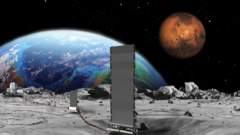NASA will fast-track its plans to build a nuclear reactor on the Moon by 2030, as reported by US media. This initiative is crucial to establishing a permanent human settlement on the lunar surface amidst increasing competition from countries like China and Russia, who are also pursuing similar projects. NASA's acting head highlighted the need for quick action to support the future lunar economy, as well as national security in space.
Transport Secretary Sean Duffy has urged commercial companies to propose reactors that generate at least 100 kilowatts of power, which is smaller than typical wind turbines. This isn't a new concept; NASA previously awarded contracts in 2022 to design a reactor. Notably, Chinese and Russian plans for an automated power station by 2035 pose further competition.
Scientists suggest nuclear energy is vital for sustained power on the Moon, especially given its long day-night cycle. Continuous power generation could support a small crew living in lunar habitats, unable to rely solely on solar power. Experts like Dr. Sungwoo Lim emphasize that nuclear energy isn't just beneficial, it's essential.
Those integrating reactors on the Moon by 2030 believe technical feasibility is within reach if funded properly, but challenges remain. Launching nuclear materials raises safety concerns, even though regulatory pathways exist. The urgency of this nuclear initiative has surfaced amid significant budget cuts to NASA, drawing scrutiny regarding the political motivations behind it, particularly with the new international competition for lunar resources.
Critics warn that nationalism could overshadow collaborative exploration efforts. The introduction of safety zones following the Artemis accords may lead to claims of ownership over lunar areas, complicating international relations. The NASA Artemis 3 program, targeting human landings by 2027, faces delays due to funding uncertainties, highlighting the difficulties ahead.
As plans unfold, the broader implications of lunar exploration for humanity must not be overlooked.
Transport Secretary Sean Duffy has urged commercial companies to propose reactors that generate at least 100 kilowatts of power, which is smaller than typical wind turbines. This isn't a new concept; NASA previously awarded contracts in 2022 to design a reactor. Notably, Chinese and Russian plans for an automated power station by 2035 pose further competition.
Scientists suggest nuclear energy is vital for sustained power on the Moon, especially given its long day-night cycle. Continuous power generation could support a small crew living in lunar habitats, unable to rely solely on solar power. Experts like Dr. Sungwoo Lim emphasize that nuclear energy isn't just beneficial, it's essential.
Those integrating reactors on the Moon by 2030 believe technical feasibility is within reach if funded properly, but challenges remain. Launching nuclear materials raises safety concerns, even though regulatory pathways exist. The urgency of this nuclear initiative has surfaced amid significant budget cuts to NASA, drawing scrutiny regarding the political motivations behind it, particularly with the new international competition for lunar resources.
Critics warn that nationalism could overshadow collaborative exploration efforts. The introduction of safety zones following the Artemis accords may lead to claims of ownership over lunar areas, complicating international relations. The NASA Artemis 3 program, targeting human landings by 2027, faces delays due to funding uncertainties, highlighting the difficulties ahead.
As plans unfold, the broader implications of lunar exploration for humanity must not be overlooked.
















